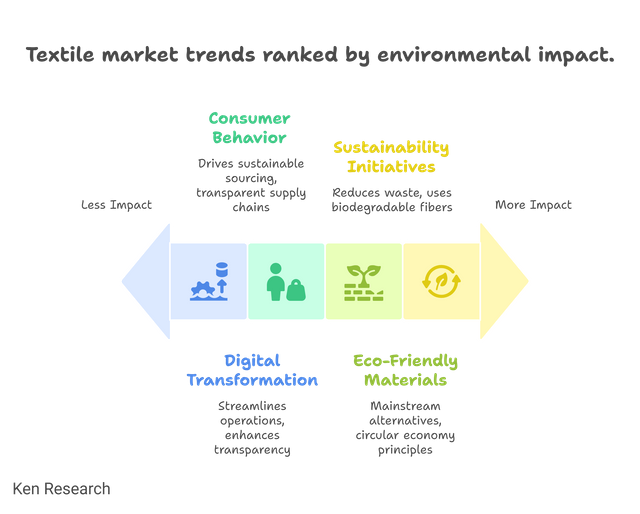Trends And Innovations Driving The Global Textile Market
The global textile market is undergoing transformative changes driven by sustainability, digitalization, and the growing demand for eco-friendly materials. These trends are significantly influencing industry practices and consumer preferences, creating a new framework for growth and innovation.
- Sustainability Initiatives: Increasing environmental concerns are pushing manufacturers towards sustainable practices. Brands are focusing on reducing waste through strategies like recycling and the use of biodegradable fibers, which appeals to environmentally conscious consumers. Initiatives such as the Fashion Pact aim to boost sustainability in the industry by committing to measurable actions.
- Digital Transformation: The incorporation of cutting-edge technologies such as AI, IoT, and blockchain is revolutionizing supply chain management and inventory control. This digitalization streamlines operations and enhances transparency, enabling companies to better respond to changing consumer demands and market conditions. For instance, RFID technology is being used to track materials and products effectively.
- Growth of Eco-Friendly Materials: As consumers increasingly seek out ethical products, the demand for eco-friendly textiles is surging. Innovations like organic cotton, recycled polyester, and hemp are becoming mainstream alternatives, reflecting a shift towards circular economy principles. This trend is supported by various certifications that validate sustainable practices and materials.
- Impact of Consumer Behavior: Modern consumers are leaning towards brands that prioritize sustainability and ethical practices. This change in consumer ethos is compelling companies to adopt more transparent supply chains and invest in sustainable sourcing, impacting business strategies across the textile spectrum.
The interdependence of these trends is reshaping the landscape of the Global Textile Market, where adaptability and innovation are key to meeting both regulatory requirements and consumer expectations. For more extensive insights, refer to the Global Textile Market report.
.png)
Emerging Opportunities in the Textile Sector
The textile sector is experiencing transformative changes driven by technological advancements, the rise of niche markets, and the growing influence of e-commerce on distribution channels. These factors create significant opportunities for innovation and growth within the industry.
- Technological Advancements: The integration of smart textiles and wearable technology is on the rise, enabling enhanced functionality such as temperature regulation and health monitoring. This innovation is fostering new product lines, appealing particularly to consumers seeking personalized solutions. Additionally, automation in manufacturing processes is reducing costs and enhancing efficiency, making it easier for companies to adapt to market demands.
- Niche Markets: There is an observable shift toward sustainable and eco-friendly textiles, with consumers increasingly preferring products that minimize environmental impact. Specialty fibers, such as organic cotton and bamboo, are gaining traction, appealing to environmentally conscious buyers. Furthermore, performance apparel is also expanding, catering to fitness and lifestyle-oriented consumers seeking high-quality, durable clothing.
- E-commerce Influence: E-commerce platforms are revolutionizing distribution processes in the textile sector. Brands are leveraging online sales channels to reach a broader audience, providing consumers with convenient access to diverse product offerings. Online customization tools allow customers to create personalized products, enhancing engagement and loyalty. This shift not only broadens market reach but also responds to changing shopping behaviors, particularly among younger demographics.
- Regional Development: Emerging markets in Asia and Africa are experiencing rapid growth in textile production and consumption. Investments in technological infrastructure are enhancing production capacity, while favorable trade policies are opening new avenues for export. Companies that strategically position themselves in these regions can tap into a vast consumer base, potentially leading to increased market share and revenues.
As the textile sector evolves, these emerging opportunities present numerous avenues for innovation and growth, ensuring that stakeholders remain competitive in a dynamic market landscape. For further insights, explore the China Textile Market.
Market Outlook: Future of Textiles
The textile industry is undergoing transformative changes, shaped by emerging technologies, consumer preferences, and global dynamics. As sustainability and innovation take center stage, experts predict significant growth and evolution in this sector.
- Global Growth Trends: The global textile market is projected to experience substantial growth, with an expected CAGR of 4.5% during 2022-2028, driven by rising demand in emerging markets and increased consumer spending on apparel.
- Sustainability Initiatives: A critical driver of future growth in textiles is the shift towards sustainable practices. Companies are increasingly adopting eco-friendly materials and processes, aiming to reduce waste and carbon footprints to meet consumer demand for sustainability.
- Technological Advancements: Innovations in smart textiles and wearable technology are gaining traction. Advances in fabric treatments and integrating electronic components into textiles create new opportunities for functionality, enhancing consumer experiences.
- Globalization Impact: Factors such as international trade policies and shifting manufacturing bases are reshaping the global textile landscape. The rise of e-commerce platforms enhances market accessibility, allowing brands to reach consumers directly, thus altering traditional distribution models.
The combination of these drivers illustrates a robust future for the textile industry. However, challenges such as economic fluctuations and competition from low-cost producers may hinder growth. Ultimately, companies that embrace innovation and sustainability are likely to thrive in this evolving market landscape.
Conclusion
The global textile market is a dynamic and pivotal sector that influences various industries, from fashion to interior design. As businesses adapt to changing consumer preferences and increased awareness of environmental issues, they not only ensure their survival but also open opportunities for growth and sustainability in the market. For more detailed insights, explore the North America Technical Textile Market.
"